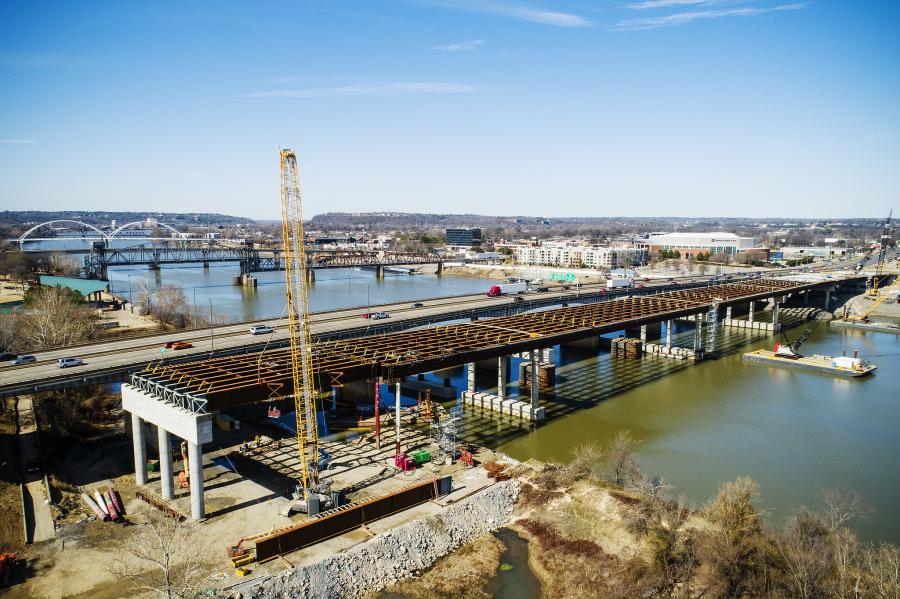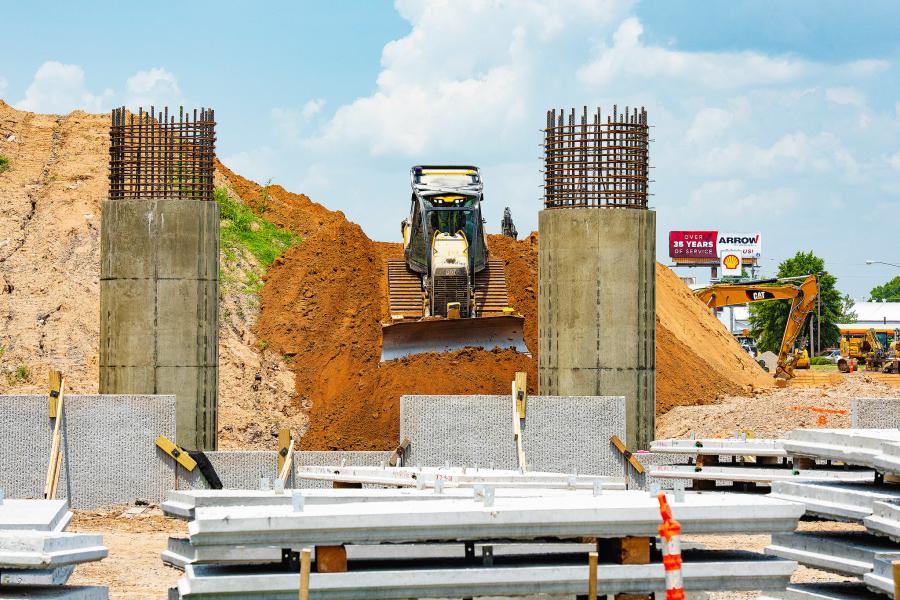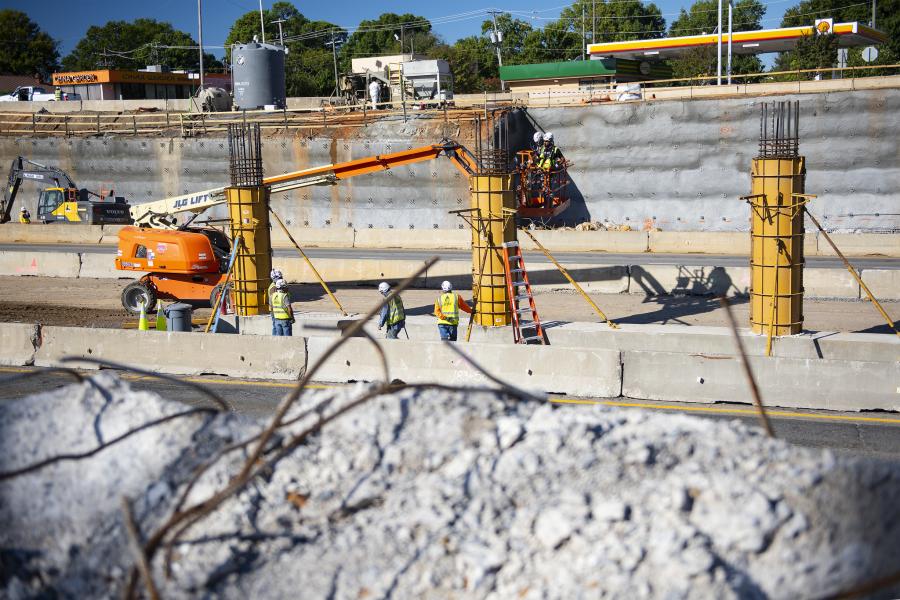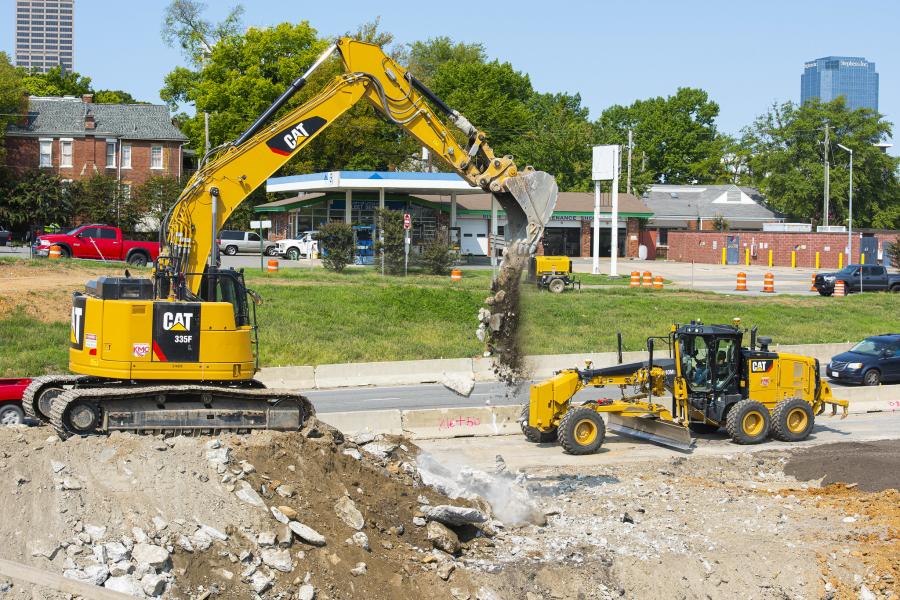The Arkansas Department of Transportation (ARDOT) is overseeing phase one construction, a $633 million undertaking
(ARDOT photo)
Designed to manage congestion and enhance access to the downtown areas of Little Rock and North Little Rock, the 30 Crossing project will make improvements to one of the most heavily trafficked corridors in the state. The Arkansas Department of Transportation (ARDOT) is overseeing phase one construction, a $633 million undertaking.
"Originally opened to traffic in 1957, the existing I-30 bridge spanning the Arkansas River was at the end of its useful service life," said Keli Wylie, ARDOT's alternative project delivery administrator. "The purpose of this project is to increase the safety of vehicular traffic on I-30 and I-40 by correcting geometric deficiencies, improving the condition of the roadway by modernizing infrastructure and maintaining a state of good repair."
The project, ARDOT's first design-build effort, also will remove a structural bridge foundation obstruction from the center of the McClelland-Kerr Arkansas River Navigation System channel, which affects river navigation by dividing the channel into two navigational spans, creating substandard horizontal clearance in both spans.
The I-30 corridor through the downtown areas currently accommodates 120,000 vehicles per day. I-30 serves state and regional traffic passing through Little Rock and North Little Rock, but also provides significant local access to the downtown areas. More than one third of the daily traffic consists of residents using the I-30 corridor to travel to destinations within the project area. Daily truck traffic on I-30 at the Arkansas River Bridge is only 6 percent, due to the existing bypass route of Interstate 440.
"The I-30 Arkansas River Bridge provides one of three vehicular crossings in downtown Little Rock and North Little Rock over the Arkansas River," said Wylie. "The Arkansas River is an important shipping channel and is maintained by the United States Army Corps of Engineers. The United States Coast Guard is responsible for navigation in the Arkansas River and for permitting of bridges on the Arkansas River."
Demolition of the existing I-30 bridge over the Arkansas River began in September 2022, with a three-phase traffic shift onto the newly constructed eastbound Arkansas River bridge. Once the traffic shift was complete, crews began demolishing the concrete bridge deck, beginning at both the north and south end bents.
After deck removal, the structural steel was dismantled and removed from the site. The existing bridge foundation was removed down to the water line and explosives were used via underwater detonation to demo the foundations below the surface of the riverbed.
Once all demo was complete, the contractor used underwater sonar mapping to ensure that all construction debris was removed from the Arkansas River. The demolition was completed in five months, which was ahead of the scheduled completion date.
KMC (Kiewit Massman Construction), a joint venture between Kiewit Infrastructure South and Massman Construction Company serves as the contractor.
KMC limited its demolition work to daytime hours to minimize noise for downtown residents. In addition, ARDOT worked with KMC to notify the public, residents and business owners about the potential for construction noise during the duration of the demolition.
Wylie said the phased construction and urban environment have presented challenges, such as small/disjointed work areas, heavy traffic, night work and restrictions on lane closures. Currently, crews are focused on the westbound river bridge foundations and substructure, retaining walls, asphalt paving, traffic barrier, concrete flatwork and drainage. Work is already completed on the eastbound I-30 river bridge, as well as adjacent roadway improvements and demolition of the existing river bridge.
The teardown involved four phases, including deck removal using Cat 325 excavators with hammer attachments; structural steel removal using several cranes including a Manitowoc 4600 ringer and a Cat 390D with shear attachment; pier removal above the waterline using a Volvo EC750E HR with hammer attachment; and pier removal below the waterline using explosives and the Volvo EC750E HR for rubble retrieval.
"There was a brief period in which the existing bridge demo was winding down, and foundation operations for the new bridge were ramping up at separate headings," said Wylie. "The new bridge will have virtually the same alignment as the previous bridge to tie into the adjacent lanes in both Little Rock and North Little Rock. This is a good plan because it enables us to open the westbound bridge faster."
Construction on the project is more than two-thirds complete. Tasks remaining include the westbound I-30 river bridge foundations; substructure and superstructure; westbound I-30 to westbound 630 direct connector; I-30 to I-40 connector; and westbound Washington and Broadway bridges in North Little Rock.
As for the weather, periods of high water on the Arkansas River can present unsafe working conditions that prevent normal barge/tug operations, while work in the winter and spring can be significantly slower than in summer and fall because of the colder temperatures and precipitation. Regarding excavation, at the I-30/I-40 interchange an existing sanitary sewer line runs under the proposed embankment.
"The project team was particularly concerned that the embankment could settle the utility," said Wylie. "Various options were considered to protect the line. Ultimately, the contractor utilized an ultra-lightweight foam glass aggregate as backfill material over the sanitary line to minimize load. This is the first time ARDOT has used this product."
Approximately 400,000 cu. yds. of excavation and 450,000 cu. yds. of embankment will be moved during construction.
Main equipment includes Cat motor graders (140); HPM & CZM drill rigs; Cat excavators (305 to 390); Tadano rough terrain cranes (GR-800XL); Manitowoc cranes (888 to 4600); Liebherr cranes (1200 to 1500) ; Cat loaders (938 to 966); JLG; Genie manlifts (60- to 125-ft.); HPSI, APE pile hammers; as well as various barges, tugboats and crew boats.
The project requires 22,000 tons of structural steel; 155,000 sq. ft. of precast concrete panels; 140,000 tons of asphalt; 92,000 cu. yds. of concrete; 8,000 tons of rebar; 58,000 tons of aggregate base; and 26,000 linear ft. precast concrete drainage pipe.
Wylie noted that roadway closures are minimized to the maximum extent possible. However, when construction requires a detour and/or closure, news releases and maps are widely distributed via email, ARDOT social media channels, news outlets, iDrive Arkansas and on the 30 Crossing webpage.
While the estimated completion date isn't until 2025, Wylie said she's pleased with the work already performed.
"It's extremely rewarding to see a project of this size and magnitude come to life from a line of a piece of paper to now being 68 percent complete, and to progress with minimal issues and traffic disruptions. That speaks volumes to the contractors working on the project, the staff on the ground inspecting workday in and day out and our entire management team. Each person plays a crucial role in the success of the project." CEG
Today's top stories































